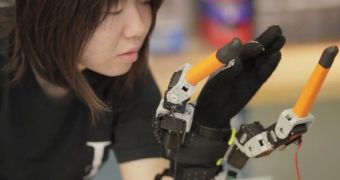Robotic science may be completely off the rails, but that doesn't have to be a bad thing, especially when it becomes the key to enhancing our already high manual dexterity. MIT has just the thing for this: robotically attached fingers.
Some may argue that having five fingers, one of which is an opposable thumb, is already enough to accomplish everything we need. After all, we've been doing that just fine for the past several thousand years.
Besides, we barely ever use the pinkie and ring fingers in creating or tinkering things anyway, so why add more?
Faye Wu and some other researchers from MIT have the answer to that: because they can, and because they can position the new fingers in more useful places, or so they feel.
You can see the idea in the picture above and the video embedded below: a glove with an electromechanical attachment that sticks two fingers to your wrist. Or makes two new fingers stick out of your wrist.
Really creepy things, longer than your actual hands and half as thick as the joint. Apparently, they are meant to remove the need for you to hold an object in place while working on it with the other hand. Or to make it easier to handle something one-handed.
Alas, the way Faye Wu chose to demonstrate that possibility is a bit unfortunate, since the cup being stirred is a lot more wobbly after the wrist-finger glove (supernumerary robotic limb if you want to be technical) is put into play.
How does it work? The glove isn't just there for show. It has sensors which send information to the digits, telling them when to squeeze (which they do with equal amount of force). As one might have expected, there already are people speculating how much easier this would make it to type texts on smartphones one-handed.
On that note, the fingers could conceivably stretch wide enough (without losing their grip) to hold even a small tablet steady. And if the brace holding the fingers in place can be turned somehow, the two large digits could hold something from above and below, not just the sides.
As high-tech and forward-looking as the project is, it could be a big win with mothers and dads when, say, they have to make breakfast or dinner for a large family. The glove will allow them to multitask quite well in the kitchen. Same when cleaning the house or preparing for a get-together. Finally, we don't really need to point out how useful this can be to amputees.

 14 DAY TRIAL //
14 DAY TRIAL // 